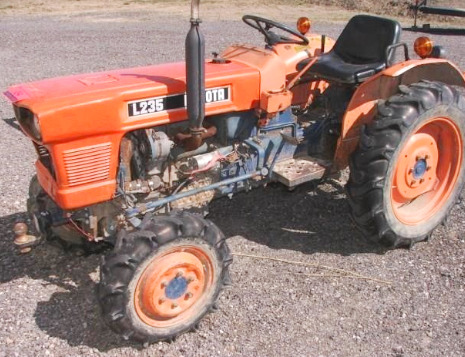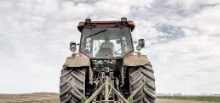________________________________________________________________________________________
Kubota L235 Troubleshooting
 The
Kubota L235 is a 2WD or 4WD compact utility tractor. This model was manufactured
from 1981 to 1985. The Kubota L235 is equipped with a 68 cu.in (1.1 L) Kubota
D1102-A vertical 4-cycle 3-cylinder diesel engine rated at 23.5 hp (17.6 kW).
The
Kubota L235 is a 2WD or 4WD compact utility tractor. This model was manufactured
from 1981 to 1985. The Kubota L235 is equipped with a 68 cu.in (1.1 L) Kubota
D1102-A vertical 4-cycle 3-cylinder diesel engine rated at 23.5 hp (17.6 kW).
The gear transmission consists of a dry clutch and gearbox with eight
forward and seven reverse gears. The maximum forward speed - 12.1 mph
(19.5 km/h), max. reverse speed - 8.1 mph (13 km/h). The open center
hydraulic system used a gear pump with a rated fluid flow of 6.2 gal/min
(23.5 l/min).
The main relief pressure is 2250 psi (155 bar). The Kubota L235 was
equipped with a manual or power assist steering system, wet disc brakes,
4.00x15 (2WD) or 9.5x24 (4WD) front tires, and 25x8.50-14 (2WD) or
16.3-16 (4WD) rear tires. The wheelbase is 66.5 inches (1680 mm) for
L235 models with 2WD and 64.6 inches (1640 mm) for L235DT models with
4WD.
| Engine Troubleshooting |
| Engine is not starting or hard starting |
| Fuel filter plugging - Replace the filter element |
| Fuel is not supplied from the tank to the system - Check the fuel shut-off valve |
| Water, dirt, or air in fuel system - Drain, flush, fill, and bleed system |
| Dirty or faulty injectors - Change fuel injectors |
| Faulty fuel injection pump - Install a new fuel pump or repair |
| Bad engine compression - Inspect cylinder block and change damaged parts |
| Engine stops during operation |
| Low coolant temperature - Warm up engine as required |
| Air in fuel pipes - Bleed fuel pipes |
| Irregular fuel injection - Adjust fuel injection timing |
| Fuel filter is clogged - Change filter element |
| Dirty or faulty injectors - Test fuel injectors and change if necessary |
| Diesel starts and immediately stops |
| Fuel injection pump timing is incorrect - Repair or replace fuel injection pump |
| Fuel filter is dirty - Change filter element |
| Fuel injector nozzles are damaged - Install a new set of well-balanced nozzles |
| Fuel injection pump malfunction - Rebuild or change fuel pump |
| Air cleaner element is clogged - Air cleaner maintenance required |
| Too low idle RPM - Normalize low idle speed |
| Faulty fuel injection pump - Replace or repair injection pump |
| Fuel injector nozzles are defective or dirty - Service or replace nozzles if required |
| Excessive valve clearance - Adjustment procedure required |
| Not enough coolant - The cooling system needs to be refilled. Inspect the system for leaks |
| Cooling system components are damaged or system is dirty - Service the cooling system or replace faulty components |
| Low engine oil level - Fill the crankcase with engine oil |
| Worn fan belt or unadjusted belt tension - Adjust properly or replace the belt |
| Thermostat fault - Check thermostat, replace if necessary |
| Fuel injectors are damaged or dirty - Check fuel injectors and replace if required |
| Insufficient fuel injection pressure - Correct the pressure settings |
| Air filter is clogged - Service or change air filter |
| Clogged oil filter - Replace or service engine oil filter |
| Diesel engine overloaded - Reduce load on the engine |
| Valve clearance is wrong - Check and adjust as required |
| Incorrect low idle setting - Normalize low idle speed |
| Clogged fuel hoses or pipes - Fuel hoses and pipes must be clean |
| Engine low compression: Valves are damaged or leaking - Valves need to be replaced |
| Abnormal engine knocking or noise |
| Timing of fuel injection pump is not adjusted - Adjust injection timing |
| Fuel injector nozzles are faulty - Change or clean injector nozzles |
| Engine oil level is insufficient - Need to add engine oil |
| Engine is cold - Warm up the engine as required |
| Main bearings or crankshaft wear - Need to install new components |
| Worn or broken piston rings - Have piston rings replaced |
| Flywheel mounting screws are loose - Tighten the screws |
| Diesel engine consuming too much oil |
| Oil leaks: Damaged gaskets or seals - Defective components must be replaced |
| Oil viscosity is incorrect - Fill up with the proper oil viscosity |
| Piston rings are seized or worn - Change the piston rings as required |
| Valve guides or stems are damaged - Valves need to be changed |
| Worn cylinder liners or pistons - Check pistons and liners, replace as required |
| Electrical System Troubleshooting |
| Battery is not charging |
| Battery is defective - Battery change required |
| Bad battery electrical wire harness - Check wires for malfunctions, repair or replace |
| Battery cables and terminals are corroded or loose - Service or tighten battery cables and terminals |
| Improper belt tension adjustment or damaged belt - Install new belt or adjust belt tension as required |
| Low battery voltage - Battery is drained, charge it |
| Battery is not holding charge - Service battery or replace it |
| Battery wiring harness damage - Inspect battery wiring for damage, replace or repair |
| Corroded or loose terminals and cables - Service or tighten battery cables and terminals |
| Battery voltage is low - Charge the battery |
| Discharged or faulty battery - Recharge or change battery |
| Faulty starter motor - Replace or repair starter |
| Wiring harness is disconnected or improperly connected - Check wiring harness and reconnect properly |
| Transmission Troubleshooting |
| Gear hard to shift |
| Misadjusted or defective clutch - Clutch needs to be replaced or adjusted |
| Damaged or loose gear shift linkage - Repair or change shift linkage |
| Damaged or worn shift forks - Shift forks need to be changed |
| Defective gearshift mechanism - Replace defective components |
| Low transmission pressure |
| Oil level is insufficient - Fill up the transmission oil |
| Plugged transmission fluid filter (if equipped) - Change or clean the transmission fluid filter |
| Relief valve sticking - Install a new valve |
| Bearings are worn or cracked - Install new bearings |
| Not enough fluid in transmission - Fill up the transmission fluid |
| Dirty transmission oil - Fill up with fresh transmission oil |
| Damaged gears or improper backlash - Replace gears or set backlash properly |
| Worn or damaged shift forks - Replace the shift forks |
| Worn gaskets or seals - Change defective gaskets or seal |
| Cracked transmission case - Install a new transmission case |
| Hydraulics Troubleshooting |
| Hydraulic system overheats |
| Hydraulic system pressure is unadjusted - Adjust the pressure as required |
| Main relief valve is faulty or misadjusted - Adjust or replace the relief valve |
| Dirty hydraulic fluid - The fluid must be changed |
| Hydraulic system sucks air - Check the pump seals, suction pipe, and fittings |
| Hydraulic fluid pressure too low |
| Hydraulic fluid level is low - Check and refill the hydraulic fluid |
| Hydraulic fluid filter is clogged - Install a new hydraulic filter element |
| Hydraulic pump failure - Check hydraulic pump flow and replace pump if necessary |
| Defective or incorrect setting hydraulic control valve block - Set correctly or replace |
| Hydraulic cylinder is not working - Inspect cylinder components for wear or damage and change if required |
| Leakage in hydraulic pipes - Inspect hydraulic system for leaks and repair it |
| Hitch fails to lift or lifts slowly |
| Lack of hydraulic oil - Fill the hydraulic system with oil |
| Cold hydraulic oil - Warm up the oil |
| Hydraulic fluid filter element is dirty - Replace hydraulic filter element or service if necessary |
| Damaged hydraulic oil pump - Test the pump flow rate and install new pump if required |
| Faulty or incorrectly adjusted main relief valve - Set up or change the relief valve |
| Hydraulic control valve is faulty or out of adjustment - Change or adjust properly |
| Hydraulic cylinder is faulty - Check cylinder components for wear or damage and change if necessary |
| Broken or loose suction line - Retighten or change |
| 3-point hitch lowers slowly or won't lower |
| Hydraulic control valve block is defective or set improper - Adjust correctly or change |
| Hydraulic cylinder failure - Check cylinder components for damage or wear and change if necessary |
| Damaged lift arm shaft - Replace the shaft |
| The hitch is defective if there is internal mechanical damage - Change defective or worn hitch parts |
| Hitch jerks when lower or lift |
| Hydraulic system sucks air - Inspect the pump seals, suction line, and fittings |
| Dirty hydraulic fluid - The fluid must be changed |
| Defective hydraulic pump - Check the pump capacity and replace pump if required |
| Defective or incorrect setting hydraulic control valve block - Change or set correctly |
| Hydraulic cylinder failure - Inspect the hydraulic cylinder parts for damage or wear and replace if required |
| Steering System Troubleshooting |
| Hard Steering |
| Steering knuckle or steering column is stuck - Inspect steering column and knuckle, replace worn parts |
| Steering gearbox components are worn - Replace defective components of steering gearbox |
| Faulty drag link or tie rod - Replace or repair |
| Insufficient lubrication in steering box - Need to lubricate the gearbox |
| Not adjusted toe-in alignment - Check and adjust toe-in |
| Tires are not correctly inflated - Inflate tires as necessary |
| Excessive steering wheel free play |
| Steering column bearing or shaft is worn - Change faulty parts |
| Steering linkage assembly is worn or loose - Repair or replace steering linkage |
| Worn steering gearbox bearings - Replace the bearings |
| Front wheel hub bearings or steering knuckles are worn - Change hub bearings or knuckles |
| Damaged or worn steering tie-rod ends - Change faulty part |
| Tractor pulls to right or left |
| Worn or loose steering linkage assembly - Repair or replace steering linkage |
| Defective steering knuckle bushing - Replace knuckle bushing |
| Uneven tire pressure - Inflate the tires properly |
| Toe-in adjustment is incorrect - Adjust toe-in correctly |
________________________________________________________________________________________
________________________________________________________________________________________
| Farm Tractors Technical Specifications |
 The
Kubota L235 is a 2WD or 4WD compact utility tractor. This model was manufactured
from 1981 to 1985. The Kubota L235 is equipped with a 68 cu.in (1.1 L) Kubota
D1102-A vertical 4-cycle 3-cylinder diesel engine rated at 23.5 hp (17.6 kW).
The
Kubota L235 is a 2WD or 4WD compact utility tractor. This model was manufactured
from 1981 to 1985. The Kubota L235 is equipped with a 68 cu.in (1.1 L) Kubota
D1102-A vertical 4-cycle 3-cylinder diesel engine rated at 23.5 hp (17.6 kW).